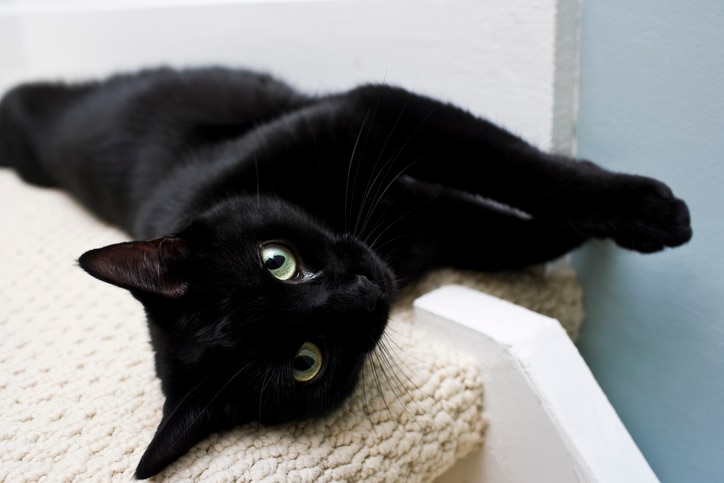Black Cat Facts: 11 Things to Know About Your Furry Friend

Photo by michellegibson / iStock / Getty Images Plus
All cats are worthy of love, whether orange and fluffy, sleek and hairless, or gray and floofy. But there’s something undeniably special about black cats.
In fact, the world has been so captivated by them for centuries that myths abound—some magical, some misguided, and some fascinating.
But there’s more to these mini panthers than meets the eye. Here are 11 facts about black cats that might just surprise you.
Black Cats Were Good Luck in Ancient Egypt …
Cats were sacred in Ancient Egypt, and the color black was associated with fertility and resurrection.
So, black cats were especially revered, and their resemblance to the powerful goddess Bastet—often portrayed with the head of a lioness or a black domestic cat—further elevated their status.
Some devoted cat lovers went so far as to offer mummified cats in her honor, and many were mummified alongside their furry companions so they could remain together in the afterlife, according to the Carnegie Museum of Natural History.
… and Queen Cleopatra May Have Been Part of the Fan Club
Rumor has it, ancient Egypt’s most famous queen, Cleopatra, owned black cats. It’s a fun thought, though no historical records actually support the claim, says Daniel Compora, a professor in the Department of English Language and Literature at The University of Toledo.
Black Cats Have a Witchy Reputation
According to Compora, the link between black cats and witches dates back to the 1500s. Cats’ crepuscular nature (often mistaken for nocturnal) likely played a key role in this association; they seemed to appear out of nowhere at dawn and disappear into darkness at dusk.
People unfairly began to see them as evil, even going so far as to say they were witches in disguise.
If not a witch, it was thought a black cat was a witch’s familiar, sent to spy or carry out other evil deeds, and some even believed that black cats were the devil in disguise.
Fortunately, today this is all recognized as nonsense, and everyone knows black cats are delightful feline angels.
Black Cats Took the Blame for The Plague
One long-standing rumor claimed that masses of black cats were killed to root out witches.
The story goes that with fewer cats around to control the rat population, rodents carrying the bubonic plague (The Black Death, which raged in the mid-1300s) flourished, and the disease boomed and led to millions of deaths. “While this makes for an interesting story, medieval scholars have debunked this tale,” Compora says.
In Some Modern Cultures, Black Cats Are a Good Sign
In some places, it’s still not unusual to wonder: Are black cats bad luck? But some cultures have it right. As long as a black cat doesn’t cross your path in Italy, you’re in luck—simply spotting one is a good omen, Compora says.
And in Japan, black cats are symbols of prosperity and good fortune, especially for single women seeking love. Even sailors once considered it lucky to have black cats on board, believing they could ensure a safe journey.
Black Cats Are Actually Very Common …
A black cat isn’t a breed in itself, though black cats are common across many feline breeds. In fact, there are only a handful of breeds where it’s unfortunately not possible for a cat to have black fur: Siamese, Tonkinese, Ragdolls, Russian Blues, and Bengals.
Why are there so many black cat breeds? It’s all in the genes! Black fur is the result of a dominant gene, meaning a cat needs only one copy to flaunt that dark coat.
The color comes from a pigment called eumelanin, which is also present in all humans and determines eye, hair, and skin color.
… But Only One Cat Breed Is Always Black
While lots of breeds may have black coats, there’s only one breed that always does: the Bombay, or “parlor panthers,” as they’re nicknamed.
They were originally bred in the 1950s by crossing a Burmese cat with a black American Shorthair.
Black Cat Fur Can Turn Orange
Your eyes aren’t playing tricks on you: Black cats’ fur really can change color. Black cats who love to lounge in the sun may have coats that lighten to shades of rust, reddish-brown, or even a soft orange.
That’s because the sun can “bleach” the pigment in their fur. But don’t fret—when your cat seasonally sheds (usually twice a year), their black coat will grow back as good as new.
Black Fur Is a Superpower
Look closely, and you might realize that your black cat actually has flecks of white on their chest, a few light whiskers, or white spots on their ears. In contrast, truly black cats have a condition called melanism, or an overproduction of the dark pigment.
Scientists speculate that melanism might cause more than a pretty coat color—it could be an evolutionary advantage.
The same gene family that gives black cats their all-black fur may also be linked to disease resistance, including better defenses against viruses such as feline immunodeficiency virus (FIV).
Keeping your black cat’s fur looking sharp is part of maintaining their health, and grooming your cat is also a great way to bond with your cat.
Recommended Product
Black Cats Have Their Own Holidays
You might treat every day like it’s a black cat celebration, but there are two official days to celebrate these special felines. National Black Cat Appreciation Day falls on August 17, while National Black Cat Day is celebrated on October 27.
Thinking about adding a mini house panther to your crew? These dates are a great time to check for adoption specials at your local shelter.
(Many shelters don’t adopt out black cats around Halloween out of an abundance of caution, so you may need to be patient and wait until November in the latter case.) You can also find ways to celebrate your own black cat each day by keeping them entertained with laser toys and mentally stimulating puzzles.
Recommended Products
Black Cat Syndrome Is Real
There are countless reasons to love black cats, but they still face lower adoption rates and higher euthanasia rates in shelters than cats of other colors, a phenomenon dubbed “black cat syndrome.”
Brown, gray, and orange cats fall somewhere in the middle, while white and uniquely colored cats are adopted most often. The bias may stem from centuries-old superstitions, but there are modern challenges, too, such as the difficulty of capturing a black cat’s features in adoption photos.
Still, there’s reason to be hopeful for black cats (and black dogs, too, who face similar adoption hurdles). A recent study published by Cambridge University Press suggests adopters are increasingly prioritizing factors like personality over coat color.
This positive shift may be thanks in part to adoption campaigns and events designed to highlight black pets and debunk outdated—and frankly, unfair—myths about these feline superstars.






